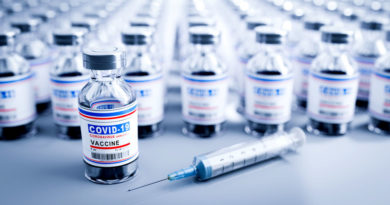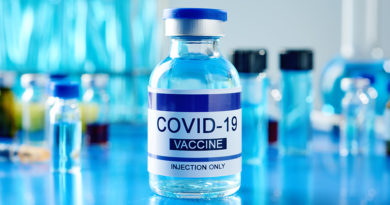Here’s What It Looks Like to Deliver Vaccines to Every Last Mile
Vaccines have likely never made more headlines than they have over the last two years, as the race to develop the COVID-19 vaccine made their importance in ensuring global health security all the more evident.
But prior to the pandemic, immunizations were already a vital part of not only ensuring health security, but also in saving millions of lives every single year. It is estimated that immunizations prevent 4 to 5 million deaths annually, and they have drastically reduced childhood mortality rates thanks to increased protection against diseases like measles, pneumonia, cholera, and diphtheria.
Still, another 1.5 million deaths could be avoided each year with improved global vaccination coverage, according to the World Health Organization (WHO).
These millions of deaths, caused by vaccine-preventable diseases, are due to lack of access to health care in some parts of the world, as well as the anti-vax movement that stems from misinformation around vaccines.
And when the pandemic hit, these barriers to vaccine coverage intensified.
While the usual challenges surrounding delivery, access, and vaccine hesitancy still existed, they were made much worse due to the fact that COVID-19 meant routine immunization programs were forced to come to a halt.
This impacted not only the actual physical delivery of the vaccines, but also the perception around them. Some public health experts now fear that the anti-vax sentiment surrounding the COVID-19 vaccine is causing an increase in hesitancy for routine immunizations, too.
Yet, thanks to organizations like UNICEF, the Global Polio Eradication Initiative, and Gavi, the Vaccine Alliance, health workers from around the world continue to carry out the life-saving work of delivering vaccines.
Because of vaccines, polio cases have decreased by more than 99% and it is on the brink of eradication. Meningitis A epidemics have been controlled and almost eliminated in 26 African “meningitis belt” countries since the introduction of the vaccine in 2010. The global measles mortality rate went down by 73% between 2000 and 2018. The world is seeing more countries implementing the human papillomavirus (HPV) vaccine to help prevent cervical cancer, which caused 342,000 deaths in 2020 alone.
These wins are not to be understated, but rather replicated, when tackling all vaccine-preventable diseases, including COVID-19. That is why it is so important for the world to continue to invest in immunization efforts at every opportunity. In a few weeks, world leaders have just that — the chance to step up in response to COVID-19 and to prepare for future threats to global health.
The US, Belize, Germany, Indonesia, and Senegal will co-host the second Global COVID-19 Summit on May 12. In the lead-up to the virtual event, the organizers are calling on world leaders, members of civil society, philanthropists, and the private sector to make new commitments to vaccination coverage and global health security.
This World Immunization Week, Global Citizen is calling out the impressive dedication of the health workers around the world that are committed to delivering vaccines quite literally through the jungle, across the desert, up mountains — all around the world.
 Health workers travel with vaccines to get to a remote outreach center at Trishal, Mymensingh, Bangladesh on Jan. 20, 2021.
Health workers travel with vaccines to get to a remote outreach center at Trishal, Mymensingh, Bangladesh on Jan. 20, 2021.
 A woman receives a dose of COVID-19 vaccination as a female health worker conducts a vaccination session in an open field outside a community health center in Banswada, India.
A woman receives a dose of COVID-19 vaccination as a female health worker conducts a vaccination session in an open field outside a community health center in Banswada, India.
 A child smiles as she sits on her mother’s lap before receiving a vaccination in an outreach EPI Center on Jan. 25, 2021 at Trishal, Mymensingh, Bangladesh.
A child smiles as she sits on her mother’s lap before receiving a vaccination in an outreach EPI Center on Jan. 25, 2021 at Trishal, Mymensingh, Bangladesh.
 A second-grade student rolls up her sleeve to receive a dose of the measles and rubella (MR) vaccines at Kroyo Elementary School in Sragen, Central Java Province, Indonesia on Nov. 24, 2021.
A second-grade student rolls up her sleeve to receive a dose of the measles and rubella (MR) vaccines at Kroyo Elementary School in Sragen, Central Java Province, Indonesia on Nov. 24, 2021.
 Health care workers are pictured outside of a home prior to vaccinating a child during a polio social mobilization activity in the community, in Kandahar, in the southern region of Afghanistan on March 8, 2020.
Health care workers are pictured outside of a home prior to vaccinating a child during a polio social mobilization activity in the community, in Kandahar, in the southern region of Afghanistan on March 8, 2020.
 Agatha Nyakayisiki, who is 9months old, holds her child immunization card as she waits in the immunization queue at Fort Portal Regional Referral Hospital in Uganda in November 2021.
Agatha Nyakayisiki, who is 9months old, holds her child immunization card as she waits in the immunization queue at Fort Portal Regional Referral Hospital in Uganda in November 2021.
 A baby is vaccinated in Boulpore, the central plateau region of Burkina Faso on July 1, 2021.
A baby is vaccinated in Boulpore, the central plateau region of Burkina Faso on July 1, 2021.
 Health care worker Ravi Chhayajyoti carries COVID-19 vaccines to a vaccination center on Aug. 2, 2021 in Doti District in far-western Nepal.
Health care worker Ravi Chhayajyoti carries COVID-19 vaccines to a vaccination center on Aug. 2, 2021 in Doti District in far-western Nepal.
 Health care workers carry vaccines through difficult terrain as part of a village health, sanitation, and nutrition day in the Chhattisgarh State, India in August 2021.
Health care workers carry vaccines through difficult terrain as part of a village health, sanitation, and nutrition day in the Chhattisgarh State, India in August 2021.
 Porters carry COVID-19 vaccines to health facilities in Jumla District in Nepal’s remote far-west region on March 5, 2021.
Porters carry COVID-19 vaccines to health facilities in Jumla District in Nepal’s remote far-west region on March 5, 2021.
 A mother holds her young child at the health center of Soamanandrariny, a rural community in Madagascar, to receive maternal and child health care services in December 2020.
A mother holds her young child at the health center of Soamanandrariny, a rural community in Madagascar, to receive maternal and child health care services in December 2020.
 A 3-month-old child receives an oral polio vaccine at the DFID and UNICEF-supported Nutrition Health Centre in Hargeisa, Somaliland on Feb. 3, 2021.
A 3-month-old child receives an oral polio vaccine at the DFID and UNICEF-supported Nutrition Health Centre in Hargeisa, Somaliland on Feb. 3, 2021.
 Karla Flores, 7, is vaccinated during a mass vaccination day in San Vicente community, Miranda state, Venezuela on Sept. 3, 2021.
Karla Flores, 7, is vaccinated during a mass vaccination day in San Vicente community, Miranda state, Venezuela on Sept. 3, 2021.
 Siblings show their marked fingers after receiving the polio vaccine in Rawalpindi, Pakistan on Sept. 22, 2020. After a six-month pause due to COVID-19, the country’s first polio vaccination campaign reached over 39 million children under 5.
Siblings show their marked fingers after receiving the polio vaccine in Rawalpindi, Pakistan on Sept. 22, 2020. After a six-month pause due to COVID-19, the country’s first polio vaccination campaign reached over 39 million children under 5.
 Vaccines are transported early in the morning in Mymensingh, Bangladesh on Jan. 25, 2021.
Vaccines are transported early in the morning in Mymensingh, Bangladesh on Jan. 25, 2021.
 Two-year-old Matias Salazar waits with his mother before getting vaccinated during a mass vaccination day in Caracas, Venezuela on May 26, 2021.
Two-year-old Matias Salazar waits with his mother before getting vaccinated during a mass vaccination day in Caracas, Venezuela on May 26, 2021.
 Kindergarten students from the Bishop Boegbah Institute in Monrovia, Liberia, proudly show their marked fingers after receiving the oral polio vaccine on March 29, 2021.
Kindergarten students from the Bishop Boegbah Institute in Monrovia, Liberia, proudly show their marked fingers after receiving the oral polio vaccine on March 29, 2021.


